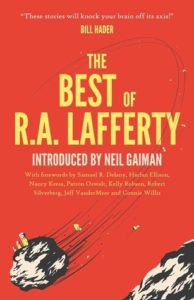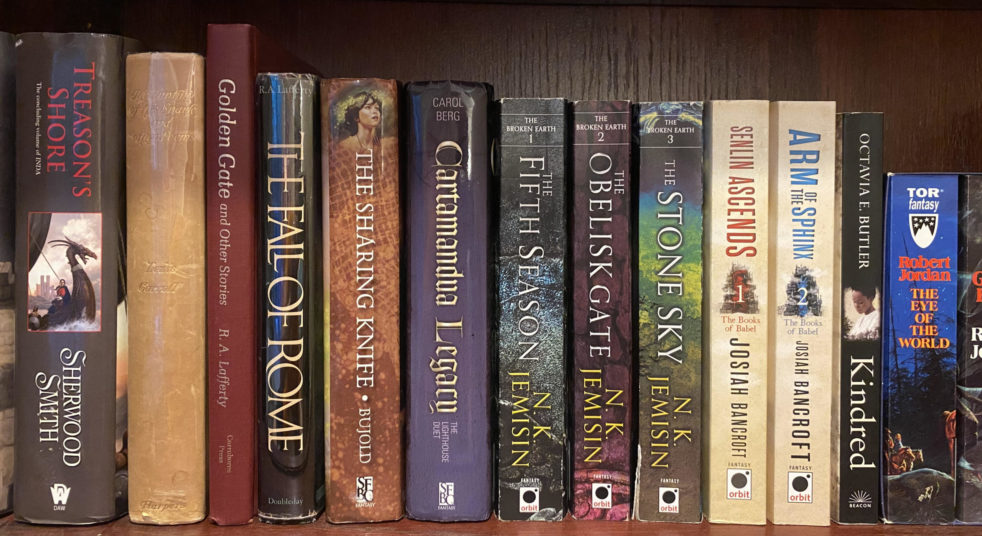
How do you review Lafferty? I asked myself a similar question when I wrote an Author Spotlight post about him last year, and it returns as I consider the short story collection The Best of R.A. Lafferty. Because this isn’t a novel, there is no plot to summarize, but even if there were, it wouldn’t come close to capturing what makes the experience of reading a Lafferty story so grand. But it is grand, and so I will try to communicate that, no matter how ineptly.
The Best of R.A. Lafferty, edited by Jonathan Strahan, was published in 2019, nearly twenty years after the author’s death, and it contains, if not the 22 best stories the man ever wrote, at least some very good ones. Nine Hundred Grandmothers is widely considered the best of Lafferty’s short story collections, and many fans consider it an unofficial Best of Lafferty. To avoid simply duplicating it, The Best of R.A. Lafferty included just eight entries from Nine Hundred Grandmothers (so that we can still look forward to a Nine Hundred Grandmothers rerelease, should we be lucky enough to ever see it) while scouring other collections for more excellent material. All told, it supplements the Nine Hundred Grandmothers selections with Hugo-winning “Eurema’s Dam,” a pair of the author’s own favorites in “Continued on Next Rock” and “Ride a Tin Can,” and a few gems rescued from obscurity (led in my eyes by “Funnyfingers,” a personal favorite that only gets better with age).
While the stories are excellent (and I’ll get to them, I promise), one of the most delightful aspects of The Best of R.A. Lafferty comes outside the stories themselves. Each piece has its own introduction written by a noteworthy Lafferty fan, from Neil Gaiman (who introduces the collection as a whole, in addition to a pair of stories) to Jeff VanderMeer to Connie Willis to Samuel R. Delany to Cat Rambo to John Scalzi to Patton Oswalt and more. And one piece has an afterword from Lafferty himself on the writing process, which has plenty to say about the process behind “Continued on Next Rock” and even more to say about creative work in general.
But to the heart of the matter, the fiction itself. I had read each piece before, albeit not in this order and with these introductions, and more than a few felt like meeting up with old friends, whereas others revealed upon reread dimensions that I had failed to grasp before. Because Lafferty is not always easy to grasp. One of the reasons he’s so difficult to review is because his writing doesn’t prioritize the aspects of storytelling that are valued in much other fiction. He’s categorized as a science fiction writer because he plays with science fiction tropes—with this collection alone featuring several interplanetary expeditions, along with a clever play on the time travel trope in “Thus We Frustrate Charlemagne”—but there’s not much science in his sci-fi, and where it appears, it as often as not serves to set the stage for something much more like a tall tale than like a classic sci-fi story.
Similarly, Lafferty doesn’t value narrative structure in the way one may expect after reading other fiction. Plenty of his stories have a clear beginning and a payoff at the end, regardless of how many impossible things happen in the middle—and these tend to be the ones that made me a fan in the first place—but others keep impossibilities close to their heart and lack any kind of closure. Pieces like “Nine Hundred Grandmothers” and “Continued on Next Rock” are among his best-regarded but left me wondering what I’d missed when I first read them as a young adult. Reading them again as part of the collection, trained a little better to dismiss my structural prejudices, I found them absolutely outstanding.
So if he can’t be bothered with hard science or coherent plot—or realistic characterization, I might add; Lafferty stories are populated with towering and wildly exaggerated figures—why is it that his stories are so outstanding? It starts with his creativity and the joy in his use of language. Lafferty may be out-of-step with mainstream speculative fiction in his absolute refusal to worldbuild and his stretching of the suspension of disbelief far past reasonable, but his penchant for the impossible comes with a willingness to dive into stories that other writers wouldn’t even consider, and the results can be stunning. Sometimes they’re easily digestible by a reader accustomed to stricter narrative conventions; after all, “Land of the Great Horses,” a forgotten history tale, is the story that made me a Lafferty fan in the first place. It opened my eyes to what science fiction could be, and it remains among my all-time favorites. But sometimes they’re a little more challenging, either pivoting to an ending that doesn’t answer what appeared to be the primary question (the reason I once disliked “Nine Hundred Grandmothers”), or introducing a tangled narrative that makes it difficult to even identify the main thread. Stacking multiple narratives atop each other—seen most clearly in “Selenium Ghosts of the Eighteen Seventies,” “The Cliffs that Laughed,” and “Days of Grass, Days of Straw”—is a particular favorite device, and it’s not unusual for characters to appear or disappear from seemingly nowhere. Sometimes the easiest tales to follow are the ones that explicitly eschew plot from the get-go, as in the delightfully impossible “In Our Block” or the day-in-the-life style “Slow Tuesday Night,” which uncannily describes the epicycles of social media trends, despite being written well before the advent of the internet. But, whether it be challenging or simple, Lafferty will push the reader to imagine tales they never would’ve considered before, and even if that imagination isn’t always easy, it’s hard to find a case where it isn’t fun.
And that fun is the second major selling point of this collection. Lafferty doesn’t write in anything near a traditional style. His authorial voice is so distinct that many have observed that you can identify a Lafferty story within a single sentence, and it’s among the biggest reasons that it’s so hard to compare him to other writers. It’s like he tears down the language and rebuilds it to suit his own purposes. And those purposes are always fun. There’s a joy in the sentences the likes of which I’ve never seen anywhere else in fiction. Lafferty considers an exaggerated seriousness to be one of the great sins of writing, and he writes such laughing and boisterous sentences that he can kill off every character in a story (and regularly does) without ever being accused of taking it too seriously. This works especially well in the pieces that most resemble tall tales. When I start saving favorite lines from a story like ”Seven Day Terror”—the favorite of Connie Willis, one of the favorites of mine, and one of the best introductions to his style, which happens to be available for free to anyone with an internet-enabled device—I run into the problem where I find myself accidentally saving every line. “Narrow Valley,” “Boomer Flats,” and “Days of Grass, Days of Straw” similarly typify that larger-than-life storytelling that keeps the tale feeling light even when the lead characters are threatened in life or limb.
But for all that Lafferty keeps the mood light, his works have a depth that can sneak up on a reader. A story that opens with a satire of over-the-top sci-fi names (for who can be a worthy explorer without a worthy name—something like Manbreaker Crag, or Gutboy Barrelhouse?) may shift into dark commentary on sci-fi colonialism. A hilarious tall tale about an Indian using ritual magic to keep invaders off his land fundamentally rests on the real-world theft of Native lands by the United States government. Included in this collection are reflections on creativity and storytelling, death and doomed love, at least one socialist dystopia and another literal genocide perpetrated by the food industry. Lafferty will tell you he’s going to break your heart, wink, and then distract you with jokes until you’ve forgotten all about the heartbreak that comes crashing down. It’s a singular style that won’t work for everyone, but if it works for you, this collection will take your breath away more than once.
Put simply, this collection is outstanding. I’m usually pretty good at finding short stories I’ll enjoy—I like about 80% of what I read, and nearly a quarter still resonates at the end of the year when I go back and reflect on my favorites. But The Best of R.A. Lafferty left my ordinary reading in the dust. I liked every single one of the 22 entries, whose worst story may have run a few pages too long but still had me cracking up more than once. I loved at least half of it—and I wouldn’t even put his Hugo-winner in that top half—and four or five are tales that I will reread again and again over the coming decades. Pretty good work for a “Best of” collection that’s missing what are perhaps my two favorites. I will never pretend that Lafferty’s style will hit for everyone, but if you enjoy speculative fiction that tackles serious subjects with a healthy dose of good humor and that pushes you to imagine in ways you’d have never considered, Lafferty is not to be overlooked. And if you’re at all intrigued by genre figures talking about what inspires them? Then score yet another mark in favor of picking up The Best of R.A. Lafferty.
Recommended if you like: short fiction, unique prose voices, humor, stories that push beyond genre expectations, contextual notes from others in the field.
Can I use it for Bingo? It’s hard mode for Short Stories. It may be a Comfort Read or a New-to-You author, depending on you.
Overall rating: 20 of Tar Vol’s 20. Five stars on Goodreads.
